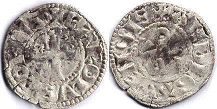Coins of Anjou - catalog with values
County of Anjou
denier
Charles I (1246-1285)
 denier no date
denier no date
silver
CAROLVS COMES
ANDEGAVENSIS
Coin value ~ 30-50 USD
Other coins of French Feudalist
Angouleme
Aquitaine
Albi
Arches and Charleville
Auxonne
Bearn
Besancon
Boisbelle and Henrichemont
Bourbonnais
Burgundy
Cambrai
Champagne
Chartres
Chateau-Regnault
Clermont
Comtat Venaissin (Avignon)
Dauphine
Dombes
Franche-Comte
Gien
Kahors
Lorraine
Lyon
Maine
Meaux
Melgueil
Metz
Navarra
Neufchateau
Orange
Penthievre
Poitou
Provence
Sedan
Strasbourg
Toulouse
Tours
Valence
Vienne
Costs of Anjou coins in this catalog approximate and indicated specifically for the coin shown in the picture.
I do not buy or sell coins - this is just a catalog.

